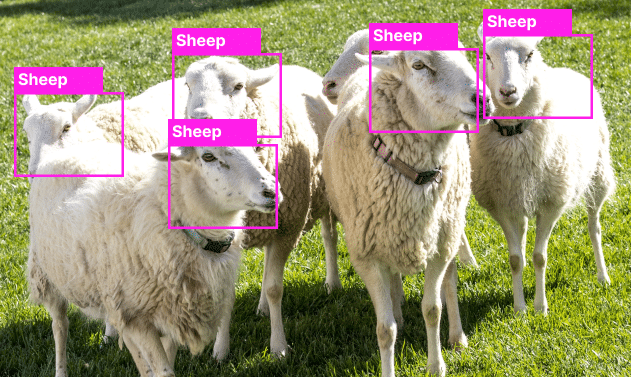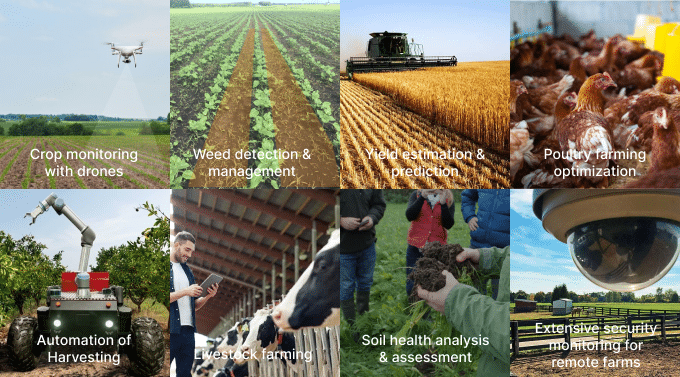- 5 min read
- Aug 6, 2024
- 0

With many technological advancements going around the world, AI is one of such revolutionary technologies that has changed the way things have been. Computer vision and machine learning algorithms have changed agriculture by enabling scalable sensing solutions. As per the latest research, it has been noted that the computer vision market is about to reach US$ 26 billion by the end of 2024. Agricultural fields require precise monitoring for vegetation detection, crop health and efficient resource allocation.
Harnessing computer vision techniques in combination with image acquisition through remote cameras has opened up different applications in the agricultural sector. In this blog post, we are going to focus on how computer vision is functional for agriculture. As the leading AI Development company, Nextbrain helps organizations to build, deliver and scale their computer vision applications. From crop health detection to real-time monitoring of harvesting and advanced analysis of weather conditions, AI-powered video surveillance has multiple applications in agriculture.
What is a computer vision system?
Computer vision is considered a field of AI that harnesses machine learning & neural networks to teach computers to derive valuable information from digital images, video streams, and others. It has several applications across agriculture, weather forecasting, healthcare, livestock farming, manufacturing, and other industries.
Applications of computer vision in agriculture

Some of the applications in agriculture comprise AI-powered animal monitoring, visual quality control, automated inspections for quality standards, and infrastructure monitoring. It has the potential to significantly improve crop monitoring and yield prediction by harnessing image analysis. It can easily identify growth patterns, plant health, and potential stress.
Crop monitoring with drones
Using drones well-equipped with AI surveillance software and advanced computer vision capabilities enables a holistic understanding of the agricultural landscape. It provides real-time crop monitoring and its advanced algorithms can seamlessly classify grade crops. AI computer vision models can detect objects and identify technical conditions in drone footage.
Weed detection & management
One of the many challenges faced in agricultural industries is a strong check on weeds through manual monitoring can be tedious. Besides helping in crop monitoring, detecting weeds, and protecting crops by minimizing fertilizers, AI surveillance software for agriculture can recognize instances of weeds through video and image data.
On top of surveillance automation, the bonus point involves the technology providing in-depth insights and analysis to initiate decision-making processes. Additionally, it helps in livestock farming, detects early signs of diseases, and stress, and prevents any kind of danger from escalation.
Yield estimation & prediction
In preharvest practices, yield estimation is one of the relevant practices. It assists you in making decisions and allocating logistics such as supplies, transportation and labour. Manual monitoring of vast quantities of fruits & vegetables is tedious. Computer vision applications led by deep learning methods will assist in precise tree counting, identifying occlusions and establishing cost-efficient and error-free processes.
Poultry farming optimization
Poultry comprises a complete range of domestic species that need timely maintenance. For building a robust infrastructure to monitor welfare and behaviour, users need advanced deep learning algorithms that allow house management automation, behaviour analysis, weight analysis, and others. Computer vision has major applications that assist in increasing product quality and farming.
Automation of harvesting
Nowadays, with increasing demand for crops throughout the year, harvesting automation has become increasingly important. It enables precise and effective picking of crops effectively diminishing the labor costs and post-harvesting process losses. Leveraging computer vision technology, users can automate the identification and selection of ripe produce. It makes sure the best quality crops are harvested. Combining high-resolution security cameras and machine learning algorithms, visual data can be analyzed in real-time and farmers can achieve consistent crop monitoring throughout the growing season. Real-time surveillance helps in the early detection of crops, weed management, constant surveillance over vegetation, safeguarding crops and optimizing resource use.
Livestock farming
Computer vision technology has major applications in livestock farming. From supporting precise monitoring of animal health to optimizing herd management, it can track individual animals by detecting early signs of diseases. Analyzing distinct factors like adjusting farming practices, enhancing productivity and detecting gait patterns can bring a massive revolution in livestock farming. It promotes biosecurity measures and with real-time monitoring of livestock, it minimizes the overall economic losses and embellishes the sustainability of farming operations.
Soil health analysis & assessment
The integration of IoT systems with AI video analytics software can use ground sensors, drone cameras, and deep learning networks for monitoring soil conditions. There are times when soil nature changes from less acidic to more and vice versa. Real-time monitoring helps in determining whether crops require irrigation. Soil assessment from time to time helps farmers to maintain a balance in vegetation growth.
Extensive security monitoring for remote farms
AI-based surveillance systems are well-equipped with AI algorithms that can seamlessly detect intrusions and anomalies with high precision. Processing video streams through AI algorithms, the systems can segregate between normal activities & potential security threats. Remote farms are mostly prone to illegal activities and therefore, it is important to have the area under strong surveillance.
AI video surveillance systems are equipped with the power to perform facial recognition under differing lighting conditions. From intrusion detection to identifying unauthorized access, the AI system helps in reducing false alarms and embellishes overall security infrastructure. Advanced methods harness deep neural networks for performing accurate face recognition for implementing deep face recognition in multiple remote farms.
Final thoughts
Looking out for ways to build a computer vision application in smart farming and agriculture? The integrated platform administers excellent end-to-end tools and machine learning model frameworks to build, deploy and scale deep learning vision solutions. To have complete control over agriculture, farmers should adopt AI-driven solutions that can assist with real-time monitoring of the produce and resolve problems. As the leading computer vision software development company, Nextbrain provides world-class computer vision applications to assist a wide range of industries. Having a proven expertise in mastering advanced technologies to create best-in-class applications for agriculture.
Feel free to connect with us if you need any assistance with agriculture computer vision application development.

